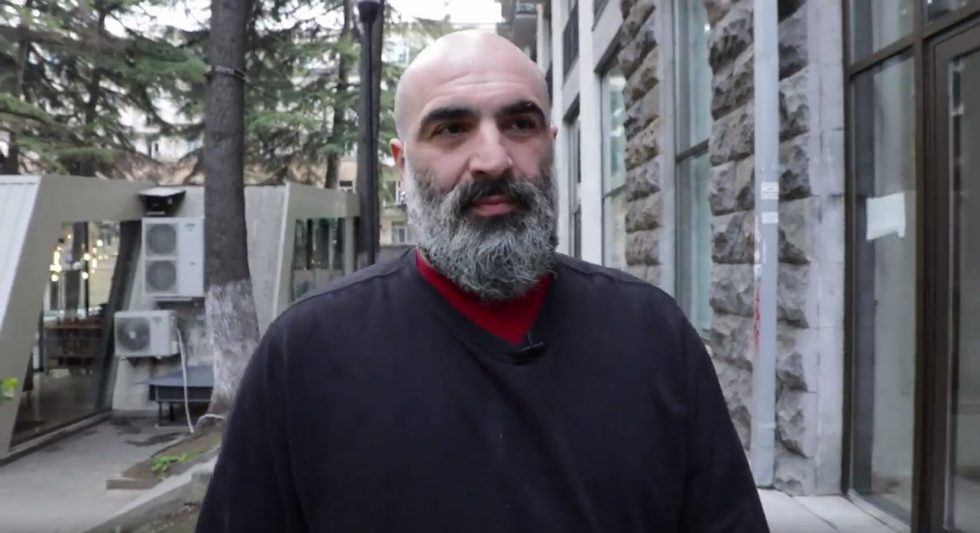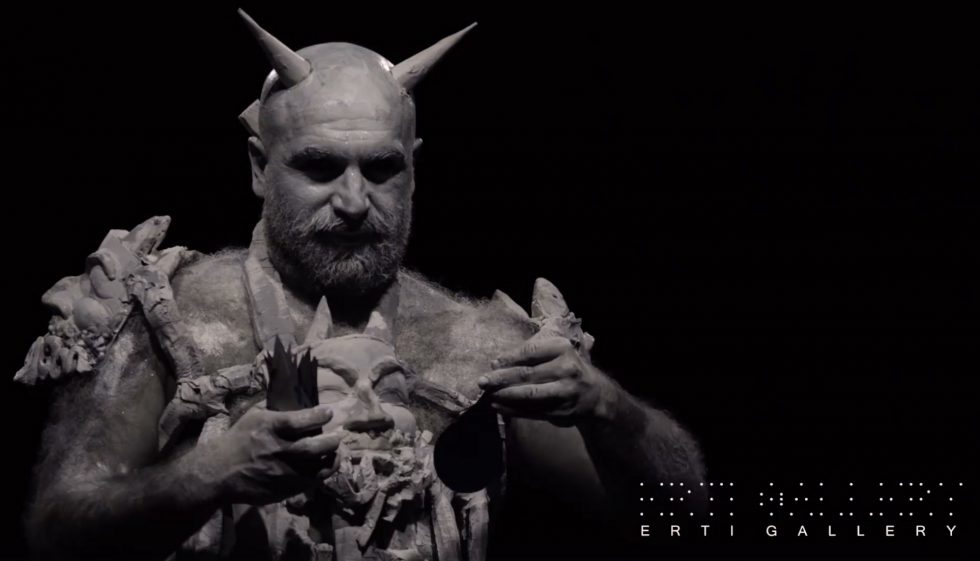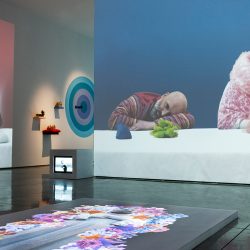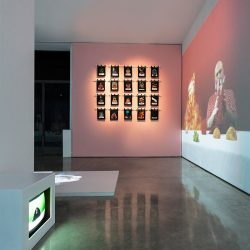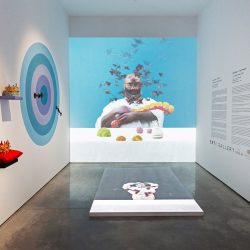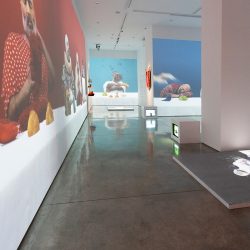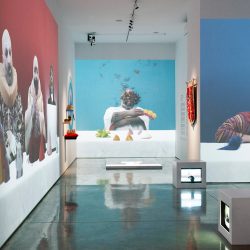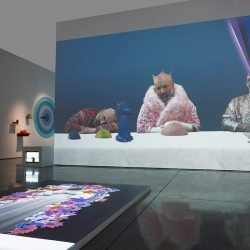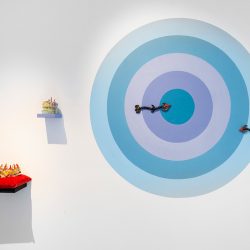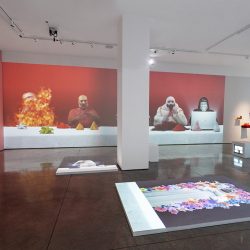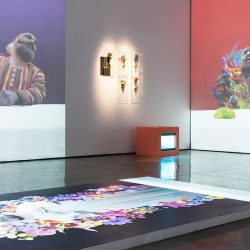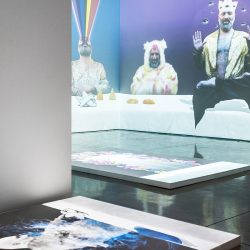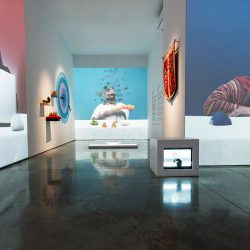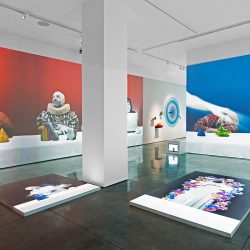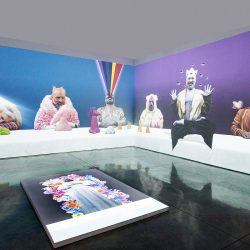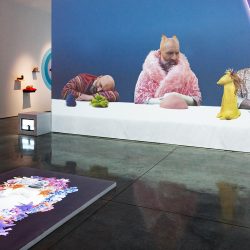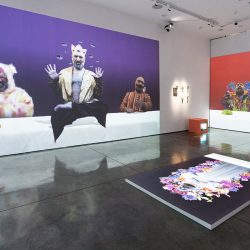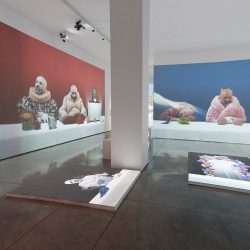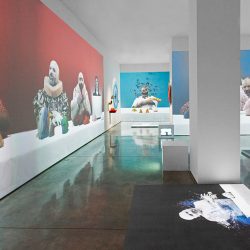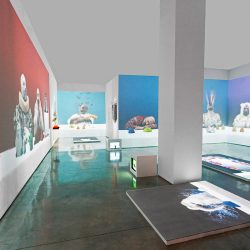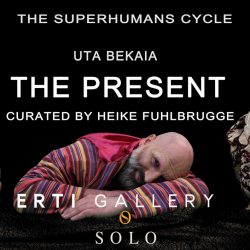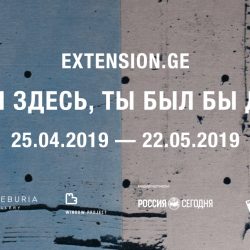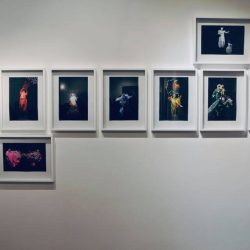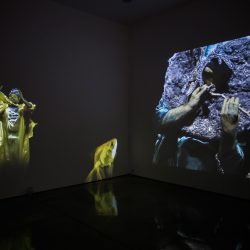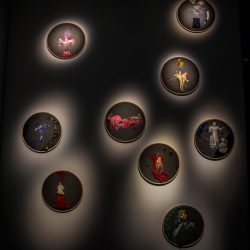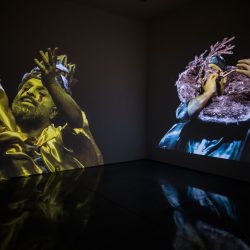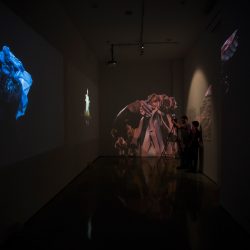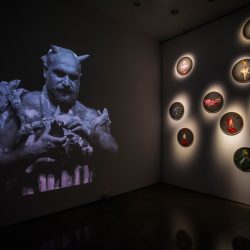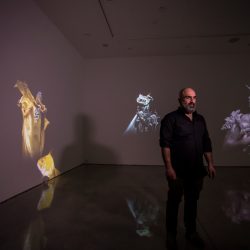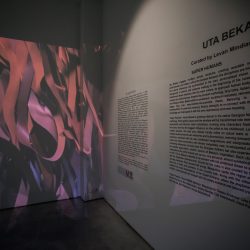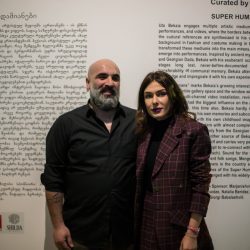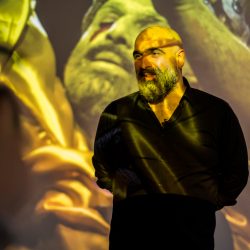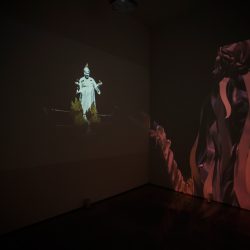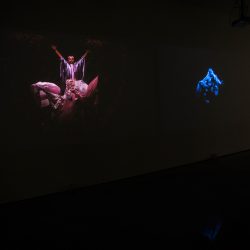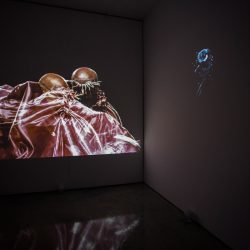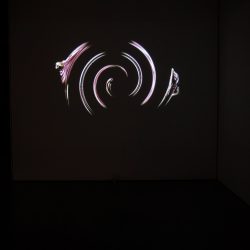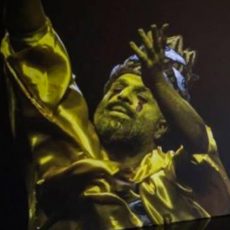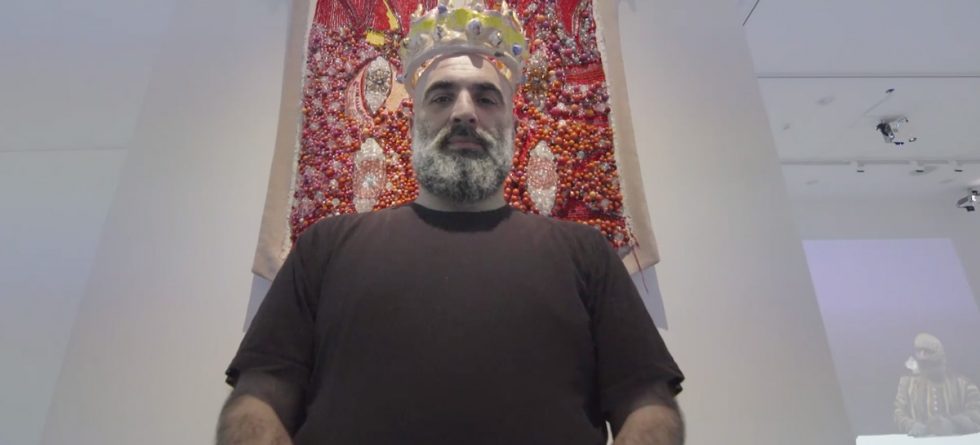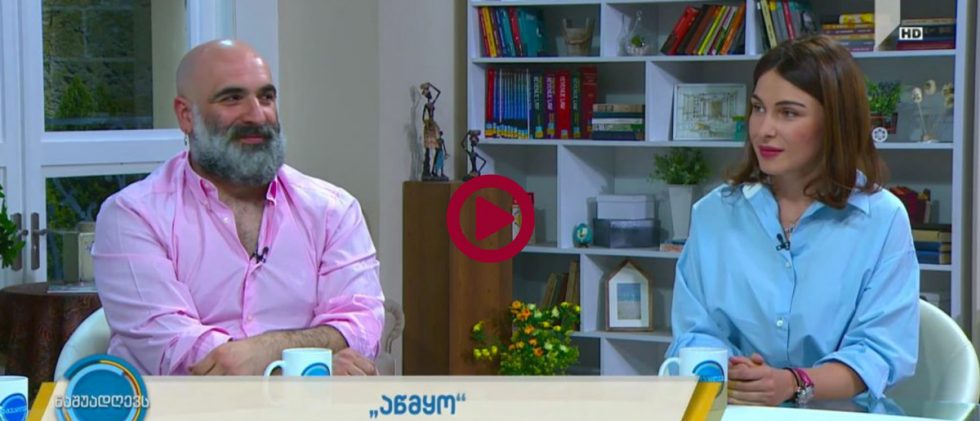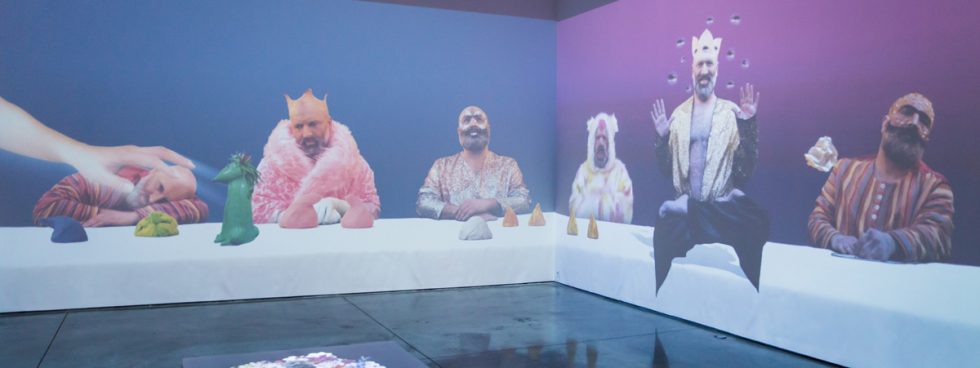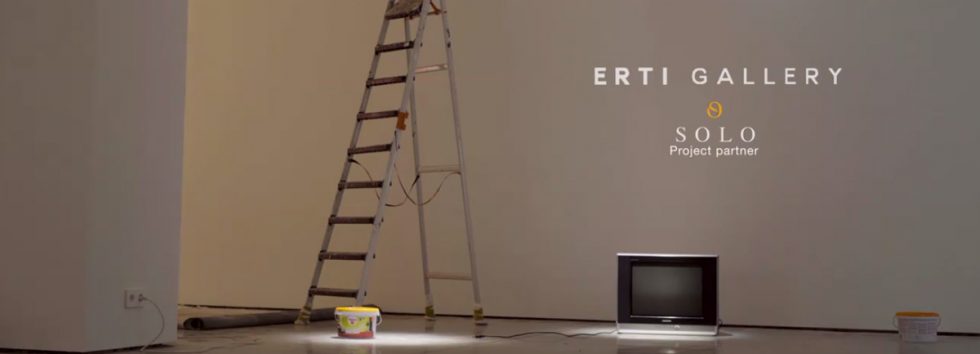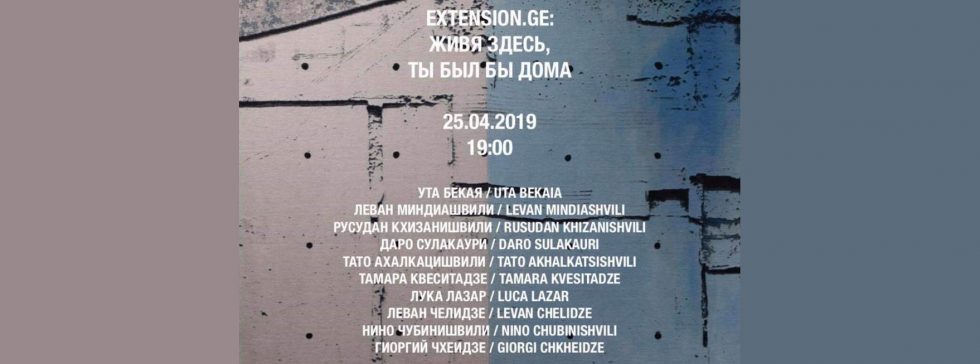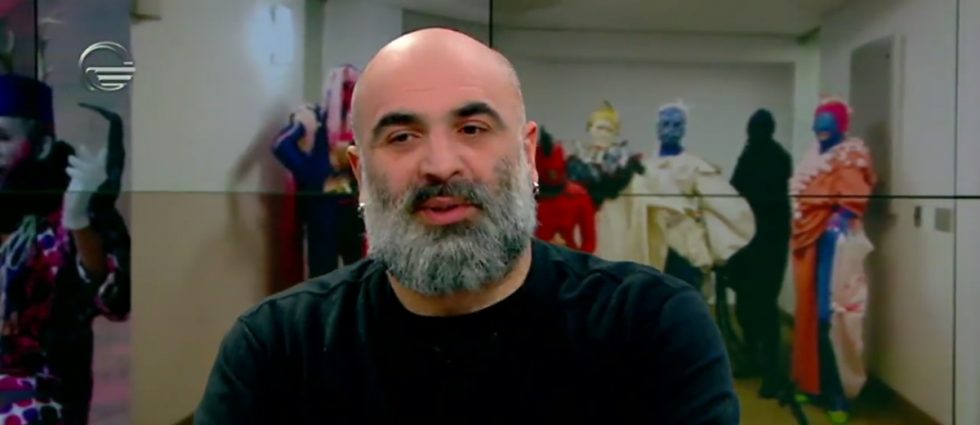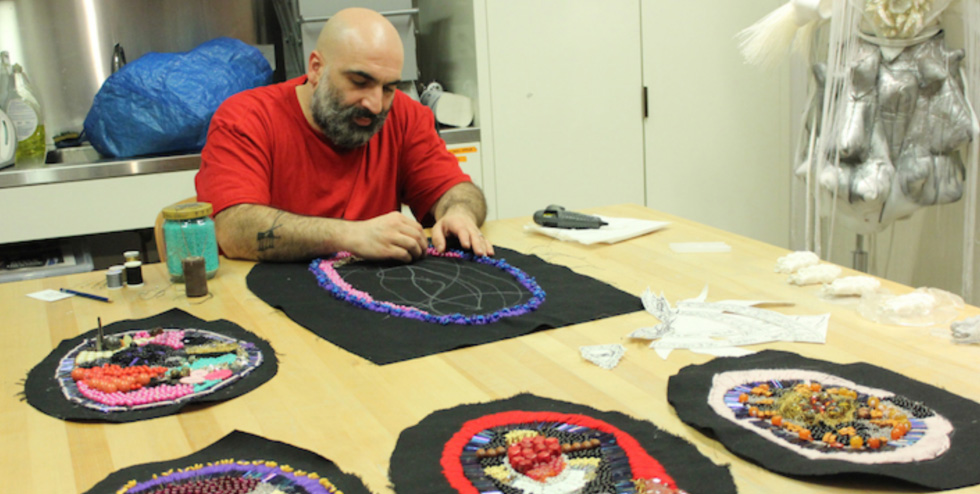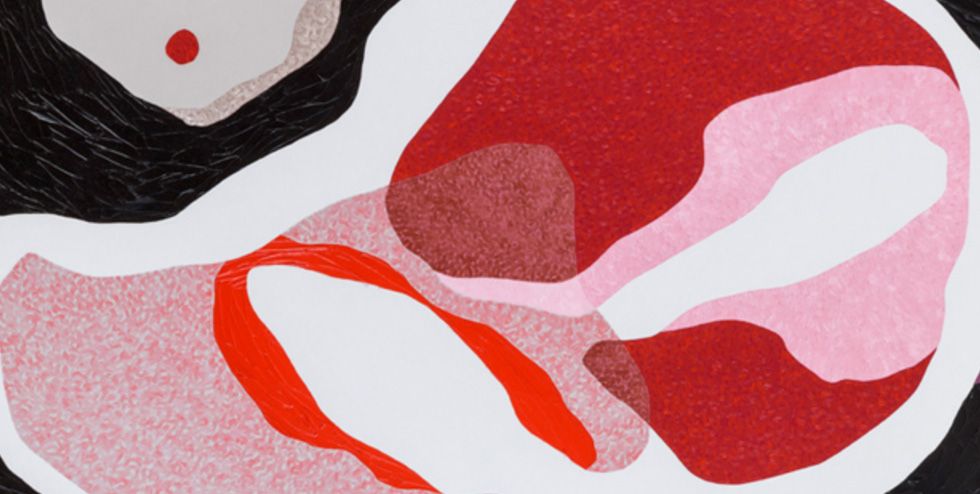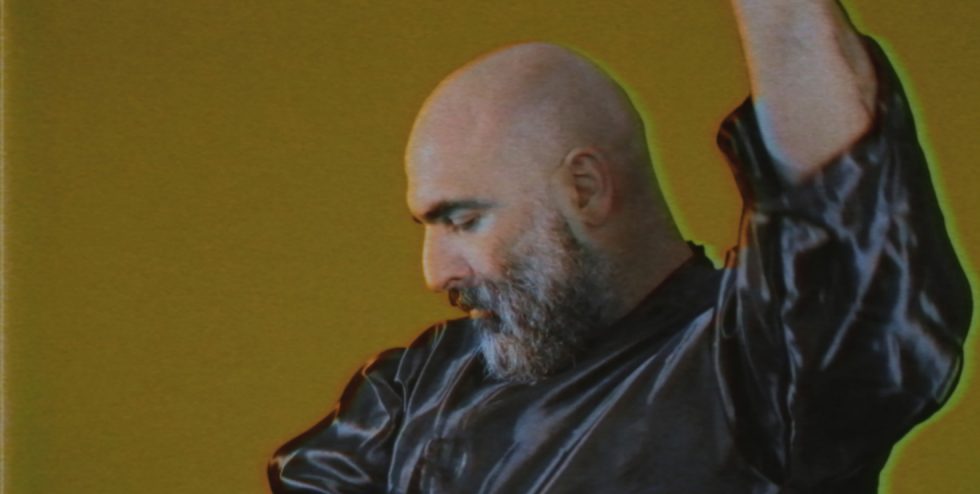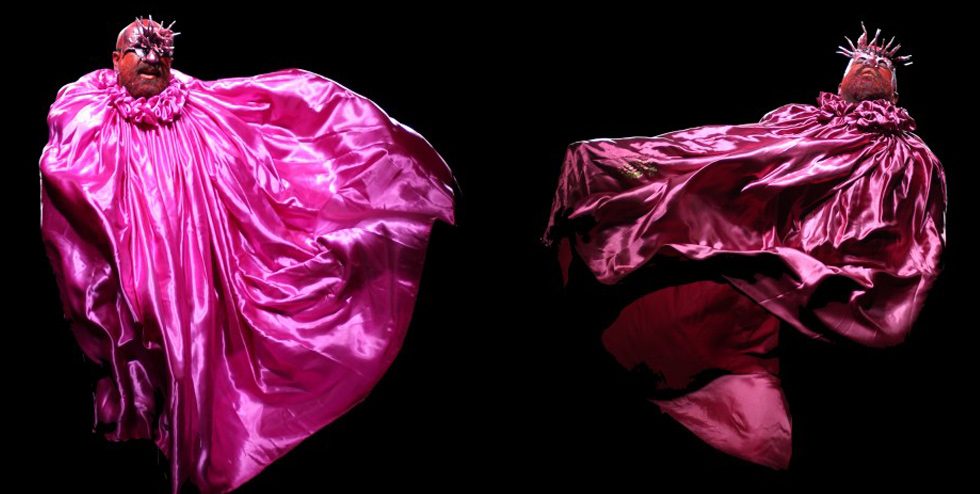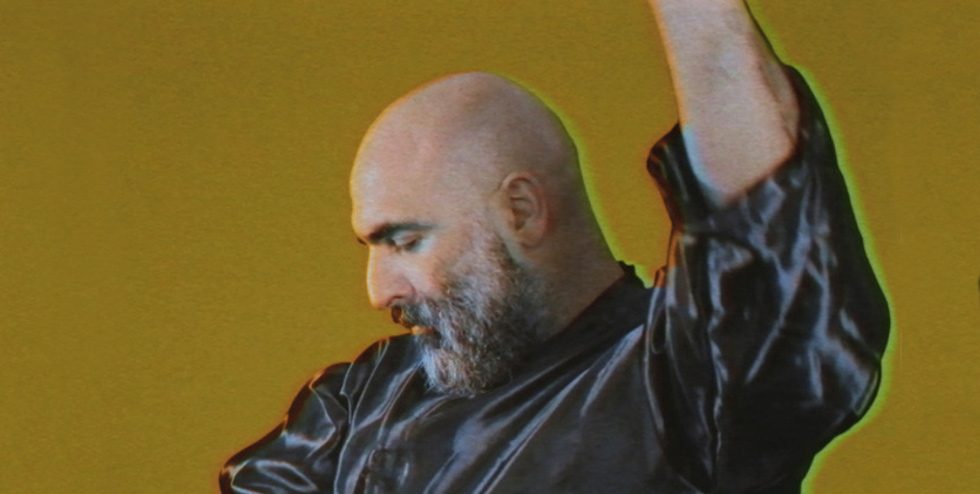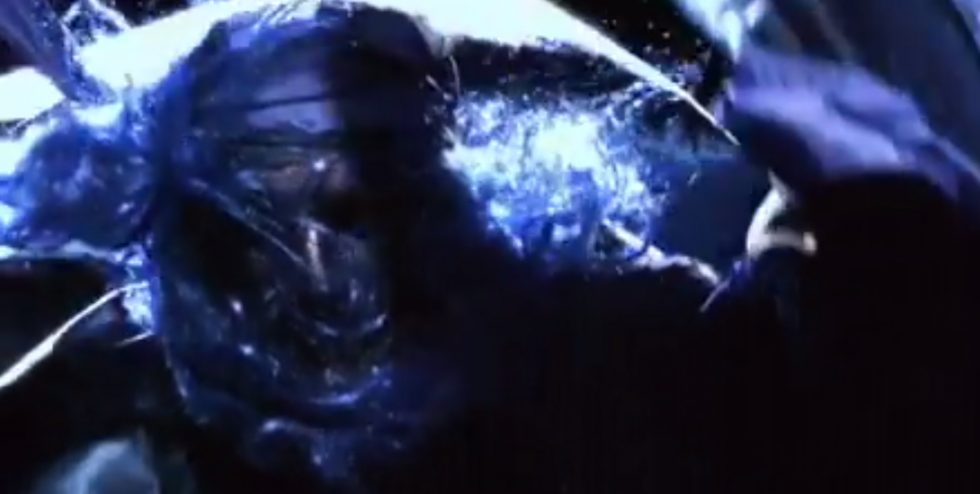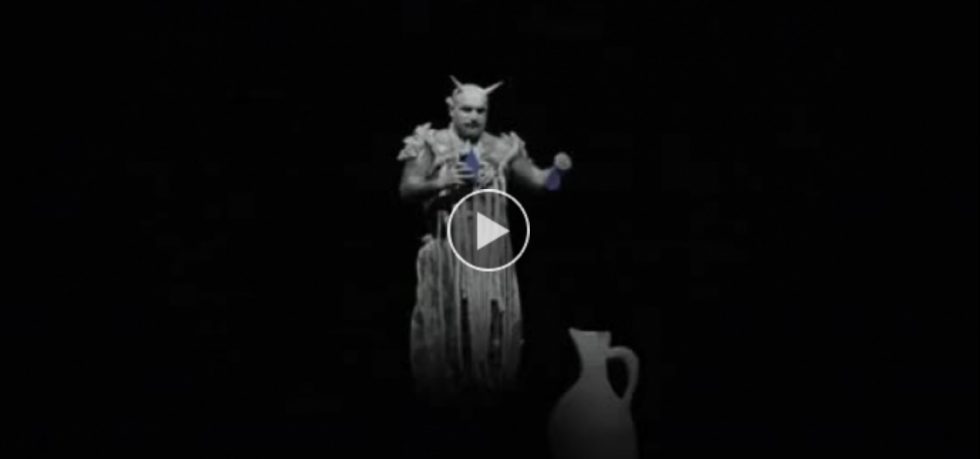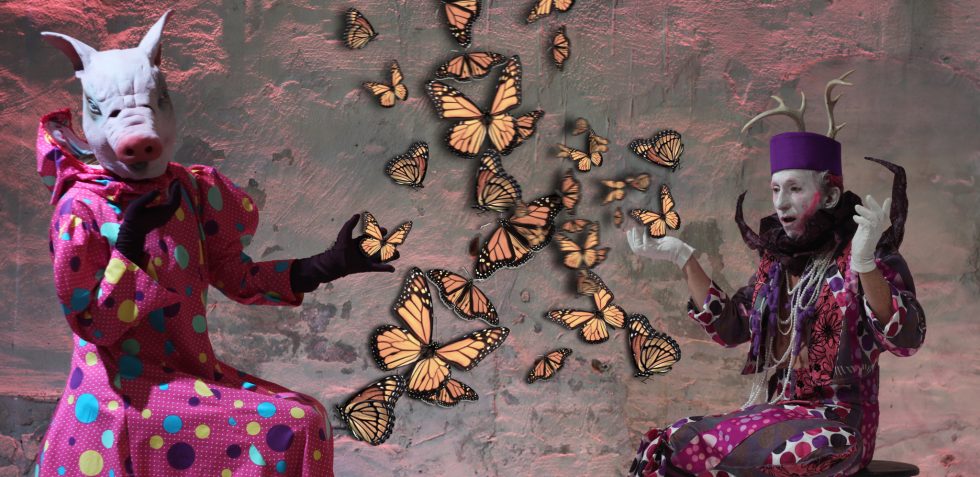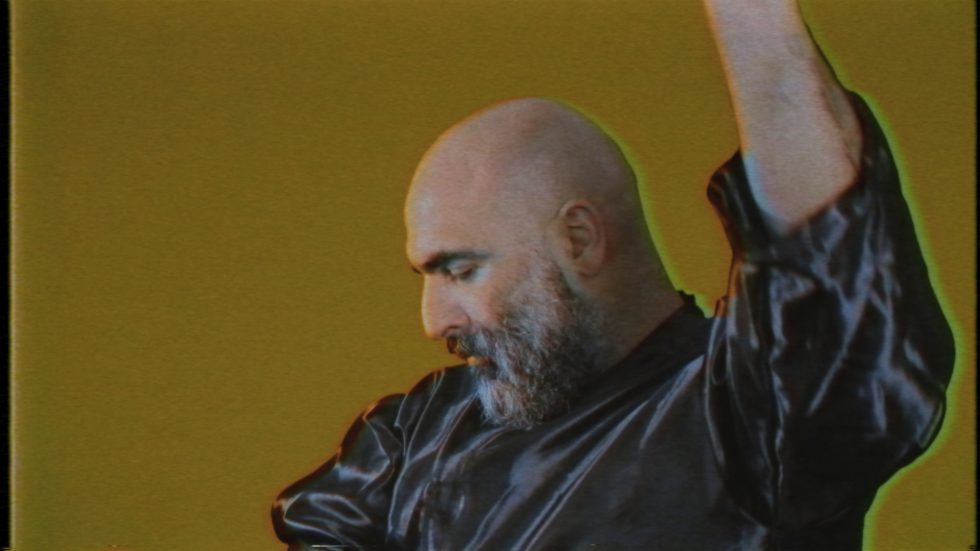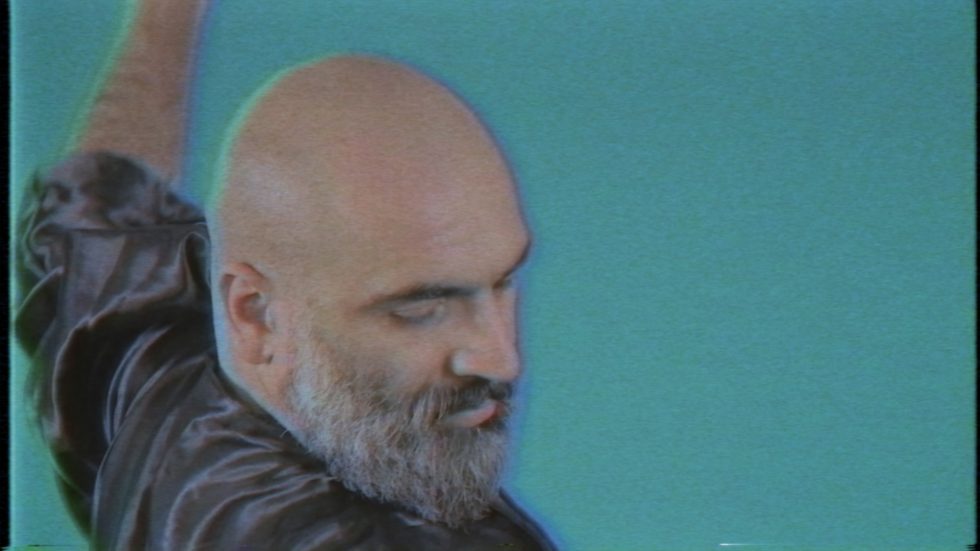-
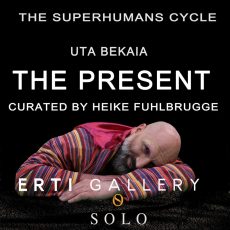 Uta Bekaia THE PRESENT curated by Heike Fulbruegge
Uta Bekaia THE PRESENT curated by Heike Fulbruegge Uta Bekaia THE PRESENT curated by Heike Fulbruegge
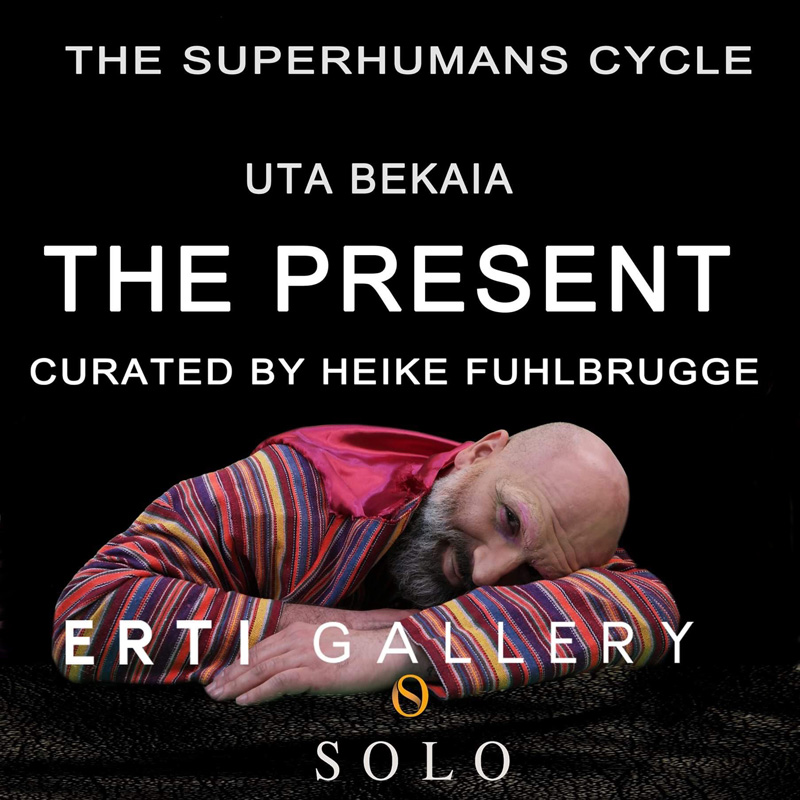
Curator: Dr. Heike Fuhlbruegge
Project Partner SOLO
Official Host Ambassador
Exhibition dates: May 15 – July 5
ERTI Gallery is pleased to present the epic second solo exhibition THE PRESENT from the multimedia trilogy The Superhumans by Georgian artist Uta P. Bekaia. The project which transforms the whole gallery space into an artistic environment interwinds video, sound, art objects, probs, costumes of different characters of the videos and embroidery works which distill the images from the videos. His works explore connections in general figures of representation, as well as – themes of conflict and failure, love, glory, repression, icons, and taboos.
Uta P. Bekaia is a master of masquerade and spectacular production. Throughout his career, he has simultaneously designed fashion, created dramatic fashion shows and artistic performances in New York. And yet his characters – he personified all of them – do not represent actual personalities. Instead, they paraphrase social and cultural stereotypes with the aim of deconstructing them through the prism of mythology, cinema, classical painting, or advertising.
„I give myself the permission to realize conscious and unconscious sides in a radical way“, describes the artist his condition when he starts his triptych cycle.
Within the new part The PRESENT of the cycle he continuous to develop his unmistakable and seminal body of work. Twenty unique characters in nine videos expand his artistic cosmos. The symbol characters are like „The Dancer, finding energy in movement“, „The Forest Man, unity with earth“ or „The Hungry Man, never enough to fill the void inside“.
Trickster – order, and disorder
A type like „The Sleeper“ reflects Bekaia’s profound research because the sleeper is always a type of cultural trickster. Known for ‘Awakening from sleep’, ‘Creation’ and ‚Rescue‘, from antique time until now. The sleeper cuts each rational order through sleep because sleep or the dream is a space without rules. In the past sleep is portrayed as the moment of religious visions, or that dreams can also be something individual, which is only generated by the soul or the thinking of a person – without the participation of God the Father or his evil opponent. This becomes especially clear when it comes to dreaming subjects that are, more or less, erotic, as in the masterpiece of Correggio of 1523: Venus. The dream of the individual also generated monsters in the Renaissance – but completely detached from New Testament hellish ideas. The monsters in the visions to be seen in the paintings of a Hieronymus Bosch, a Jan Mandijn and other mainly Northern European painters are horrendous fantasy figures, composed of human and animal bodies. In their monstrous and frightening forms, they are certainly reminiscent of those biblical apocalypse-inspired figures, but the Renaissance monsters are individualized dream-births that give birth to the sleep of reason.
State of mind
Revealing each of these characters is a result of that enormous creative effort and courage without which no mental or physical journey starts. They have now an even closer bond with each other, as the created types in the first part titled PAST (2017/2018) of the cycle. In the previous ones the artist invented, built and dressed nine characters called superhumans who he summoned from mythological-folkloric topics or collective memory using his personal memory, stores, and wardrobes. He attributed them to an individual choreography, costume, and sound. The past and present figures have a superhuman scale, a size, which exceeds human proportions.
The characters are autonomous and equitable inhabitants of the artist’s subconscious or conscious spheres. Therefore all of them occupy their deserved place around his so-called “conscious table“ (a reminiscence of the generous guest experience in the Georgian culture). Symbolizing the permanent interdependence of the physical world represented throughout materials like costumes, attributes and tarot-cards, and the dematerialized world like mental states.
I this case, the dramatic projection, or display with light is directly linked with bringing clarity and light in the hidden, dark and unconscious field, or their realization.
In deep water
Deep cultural references à la C.G. Jung are also part of the popular repertoire of the Georgian artist: C.G. Jung, for example, understood Western alchemy as depictions of alchemists who experienced their own projected unconsciously in the material. The alchemists then oriented themselves on their dreams and visions to get to the mystery of the material, but they did not yet know where to go. Thus, they were in a parallel situation to modern humans who want to explore the unknown of the unconscious psyche. The alchemists identified inorganic matter as a living unknown to which they had to establish a relationship with it. These were served by dreams, meditation exercises and the phantasy form of “Phantasia vera et non phantastica”, which largely corresponded to what Jung had developed as an active imagination.
Drama and resistance
The individual floral ceramics, – presented in acrylic boxes -, such as a rose, hyacinth, and sunflower are symbolically linked to death and love in the work of Bekaia. Already in Greek mythology, Apollon let the flower of the same name grow out of the earth, where his stunningly beautiful lover Hyakinthos was killed by jealousy of Zephyrus (the west wind).
Bekaia combined each flower with a poem, which highlights there existential drama: I looked for you / In empty places / And I found you / Within me.
So flowers – crossing epochs and cultures, they entice and seduce, unite, are a sign of either respect, optimism or opulence, seemingly free of provocation. But flowers have always been more than just a motif of longing, a dramatic symbol of the transience of life or an erotic alter ego of human sexual organs. They can also be read as political metaphors that just as much illustrate the phenomena of botanical migration into socio-politics as the encroaching heteronomy of a genetically altered reality. The classical symbolism of the rose, such as the one in Bekaia’s work, includes declarations of love, innocence, and transience. However, it once also served as a visual formula for secrecy – sub rosa – for instance among the alchemists, while the presentation of a thorn-studded rose stem even served as a declaration of war. Also, a famous resistance group during the Nazi era acted under the name of the “White Rose”.
Even the flared heart object, which is opulently decorated with hundreds of sparkling pearls, looks floral, delicate and unique: This organ is an important motif for the artist, it is an expression of the eternal energy of love and the rhythm of life.
Sparkling archive
Since Uta Bekaia not only refers to general types in his characters, as well to profoundly researched motifs in art history, he refers also to heroes in comics or landscape sequences as well as music of his childhood – the artist creates a profound and sensible, and just as sparkling cultural archive of memories and human conditions in general and in particular of the Georgian past and political present. The dramatic staging function as an archive as a metaphor in which the key is the dynamics of the permanent transmission of information.
Text: Dr. Heike Fuhlbruegge -
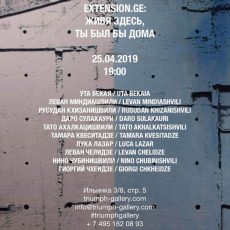 EXTENSION.GE. IF YOU LIVED HERE, YOU WOULD BE HOME
EXTENSION.GE. IF YOU LIVED HERE, YOU WOULD BE HOME EXTENSION.GE. IF YOU LIVED HERE, YOU WOULD BE HOME
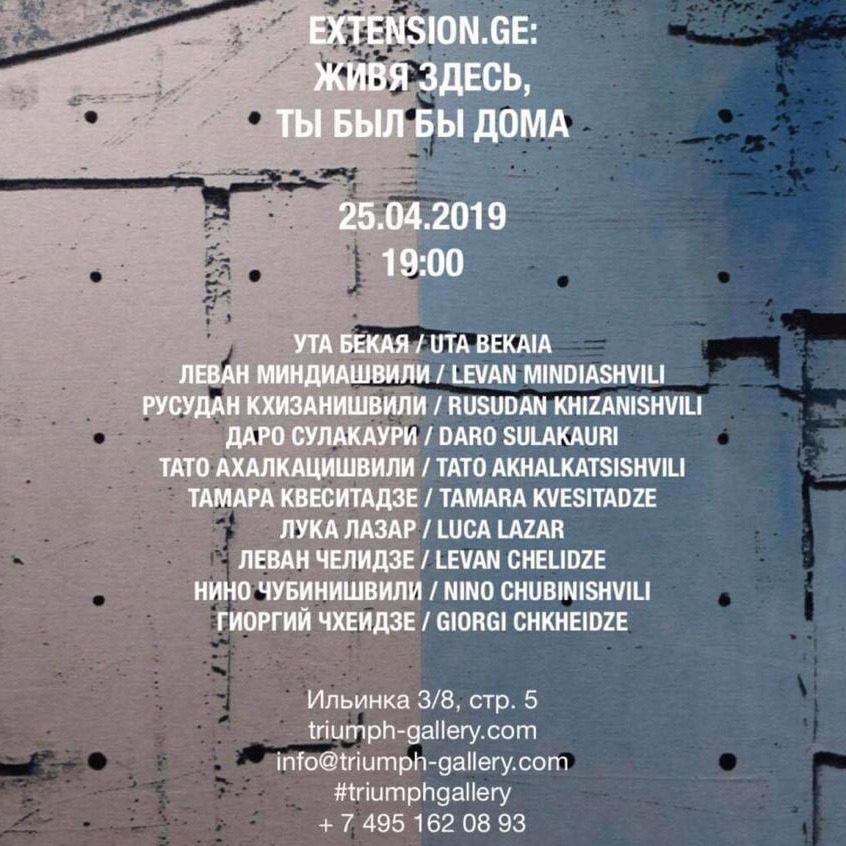
TATO AKHALKATSISHVILI, UTA BEKAIA, TAMARA KVESITADZE, LUCA LAZAR, LEVAN MINDIASHVILI, DARO SULAKAURI, RUSUDAN KHIZANISHVILI, LEVAN CHELIDZE, NINO CHUBINISHVILI, GIORGI CHKHEIDZE
Triumph Gallery in partnership with Ria Keburia Foundation, ERTI Gallery and Window Project, Tbilisi, presents the 11th edition of the EXTENSION project—If You Lived Here, You Would Be Home. In line with now traditional approach to exploring different national art scenes, ten Georgian contemporary artists, who represent various media and subject matters, are brought together by their interest in heritage and cultural memory.
Georgia has always existed at the crossroads, from the Ottoman Empire to the Soviet regime, from the Rose Revolution to the era of the new oligarchs. Having overcome a deep trauma, Georgia is now a vital link in cultural exchanges. In spite of many years of migration, regime change and economic turmoil, Georgians have managed to preserve their national heritage, avoiding the fate of “the cultural melting pot” that has befallen neighboring lands. This cultural depth and richness can be seen in the work of Georgian contemporary artists, who continue to explore their deep ties with tradition and cultural memory, even if working in cities all over the world. Georgia, with its special cadence of life, seems to have avoided the identity crisis that many other nations face today. With a slower pace to life and a tendency towards meditative contemplation, the atmosphere of this country lets you focus on actual values, reflect upon the changing present and consider alternative ways forward.
Extension.ge: If You Lived Here, You Would Be Home displays an overview of Georgian contemporary art by presenting artists with diverse background. All exhibition artists belong to the generation which is part of the new dynamic scene that looks beyond the geography of their national borders. Without ignoring their cultural identity and possessing particular experience of contemporary reality, these artists make a claim to international presence and benefit from their openness and desire for exchange.
Exploring transitional fluid state of historically accepted social forms and paradigms, the exhibition revisits the notions of place, identity and history. It doesn’t propose answers or solutions, but it does offer opportunities to closely examine artistic practices, storytelling and new perspectives. The profound intergenerational impact of postcolonialism, economic exploitation and ideology requires nuanced insights and experiential responses, which inevitably shapes the reality and brings about new artistic practices. Participants of Extension.ge: If You Lived Here, You Would Be Home are renegotiating the definitions of place and home in order build renewed links between the notions of memory, geography, identity.
-
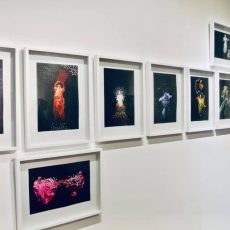 "IMAGE AND LIKENESS" – Exhibition at Moma Tbilisi
"IMAGE AND LIKENESS" – Exhibition at Moma Tbilisi “IMAGE AND LIKENESS” – Exhibition at Moma Tbilisi
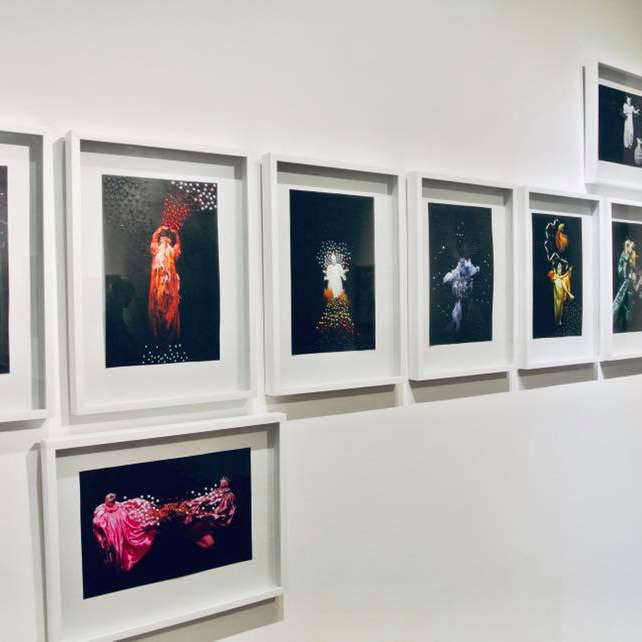
-
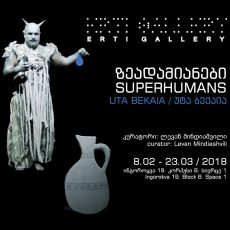 SUPERHUMANS
SUPERHUMANS SUPERHUMANS
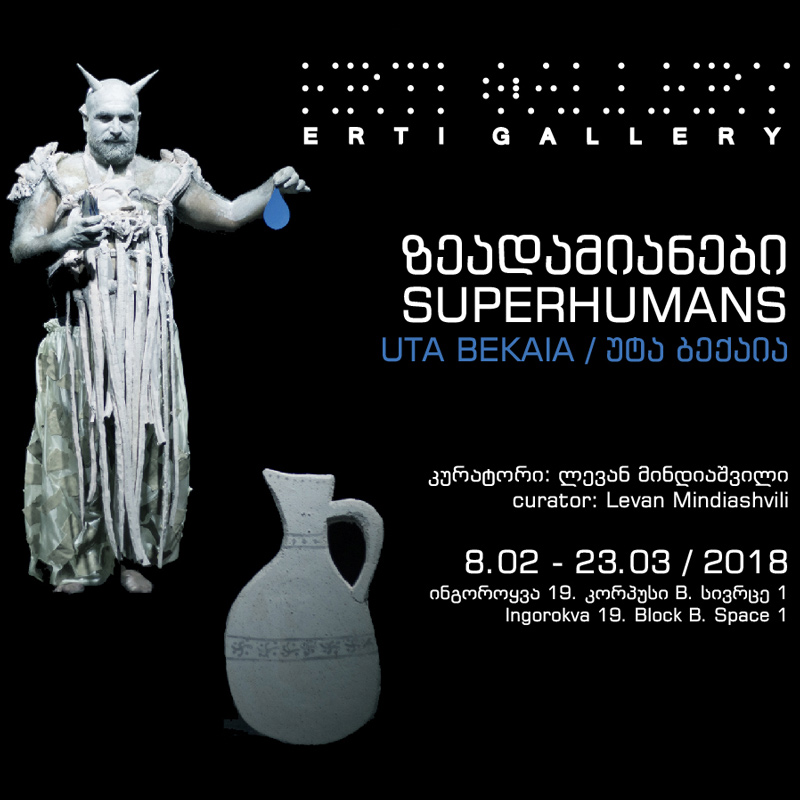
Opening Reception: February 8, 19:00
ERTI Gallery is delighted to announce a solo exhibition of new works by Uta Bekaia, Super Humans, marking the gallery’s first collaboration with the artist.
Uta Bekaia engages multiple artistic mediums, creating wearable sculptures, performances, and videos, where the borders between the disciplines are blurred, and the cultural references are synthesized in his own, personalized vision. With the background in fashion and costume making in the beginning of his career, Bekaia transformed these mediums into the main means, to approach human body and fully emerge into performances. Inspired by ancient mythology, fairy tales, Italian Baroque, and Georgian Dada, Bekaia with his exuberant, sculptural costumes, reinvents and re-stages long lost never-before-documented rituals. Believing in genetical transferability of communal memory, Bekaia attempts to re-connect with the ancient knowledge and impregnate it with his own experiences and new meaning.
“Super Humans” marks Bekaia’s growing interest in his native Georgian folklore and mythology. Entire gallery space and the window will be transformed into immersive, experiential multi-channel video installation, reviving nine characters from different fairy tales, that had the biggest influence on the artist in his childhood. Loyal to his creative process, this time also, Bekaia hardly relies on actual texts or research; instead, he dives into his own memories and subconscious, reviving remnants of those memories, enriched with his own childhood imaginations and interpretations. As a result, the viewer encounters with almost completely new, re-interpreted characters, containing references not only from the Georgian folklore but also experiences from the western pop-culture, another source of Bekaia’s inspiration. Each character is interpreted by the artist himself and carries very personal, almost symbolical meaning for him. This is Bekaia’s attempt to re-connect with his childhood dream to encounter with the Superman (Übermensch). Sound for the video is also created by the artist, reviving memories from ancient folk songs, Mengrelian spells (the region of Georgia where he’s from) and childhood summers in the country side.
Along with the videos Bekaia created nine hand embroideries of the Super Humans, where the playfulness of the children coloring books are merged with his widely explored and beloved craft.
The characters are the following:Ochopintre – soul of the forest, half human -half animal, always accompanied by two golden deer, he played on the flute and to his music, the trees and flowers would blossom;
Gulambara and Sulambara – a blind King, that in order to get back the sight, had to apply the blood of the golden Fish on his eyes.
Devi – hairy giants, that would generally occupy the springs or another source of the water and would always ask something or someone in return.
Natsarquekia – a lazy person, who would spend days in staring at the center-fire and playing with the ashes.
Tsiqara – an orphan boy, with his loyal friend bull, who would carry him through the difficulties.
Faskunji – large creature with the wings, who would carry humans on long distances over their wings, but the character should feed it constantly, even to give them their own leg.
Gatsi and Game – double God, that would become one whole time to time.
Armazi – Pagan God of the war.
Dali – Goddess of the forest, with long golden hair.
-
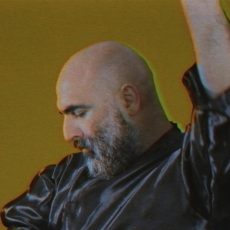 Kinto Dreams
Kinto Dreams Kinto Dreams

“Kinto Dreams” represents an artistic attempt to creative associative links between contemporary and traditional ritualistic culture. The project is based on a idea of perceiving ritual, as an altered state of consciousness, which can be reached through enhancement of rhythmic, continuous beat, homogeneous dance and psychedelic substances.
“Kinto dreams” investigates urban culture in different period of time and tries to connect old Tbilisi city Kinto dance, with blooming culture of electronic music in Georgia, both as a representation of ritualistic culture. Altogether with displayed paintings, created between 2001 -2005, as decorations for psychedelic events, the show creates comic and absurd, dreamlike expression of higher state of mind.This show is dedicated to living memory of dear friend, Chaiung Siagian.
presented by ArtArea Tbilisi
Music – Natalie Tba Beridze
Video – Levan Maisuradze / Giorgi Akhvlediani
Installation – George Babalashvili Giorgi Baba
Curator – Taso Chkheidze
Special thanks to Levan Mindiashvili
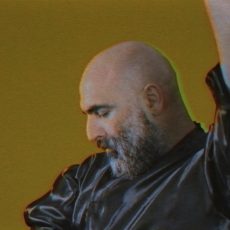 Kinto Dreams 01
Kinto Dreams 01 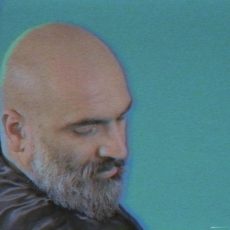 Kinto Dreams 02
Kinto Dreams 02 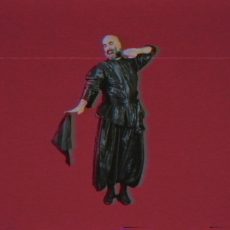 Kinto Dreams 03
Kinto Dreams 03  Kinto Dreams
Kinto Dreams Kinto Dreams
“Kinto Dreams” represents an artistic attempt to creative associative links between contemporary and traditional ritualistic culture. The project is based on a idea of perceiving ritual, as an altered state of consciousness, which can be reached through enhancement of rhythmic, continuous beat, homogeneous dance and psychedelic substances. “Kinto dreams” investigates urban culture in different period of time and tries to connect old Tbilisi city Kinto dance, with blooming culture of electronic music in Georgia, both as a representation of ritualistic culture. Altogether with displayed paintings, created between 2001 -2005, as decorations for psychedelic events, the show creates comic and absurd, dreamlike expression of higher state of mind. This show is dedicated to living memory of dear friend, Chaiung Siagian. presented by ArtArea Tbilisi Music - Natalie Tba Beridze Video – Levan Maisuradze / Giorgi Akhvlediani Installation - George Babalashvili Giorgi Baba Curator - Taso Chkheidze Special thanks to Levan Mindiashvili
Uta Bekaia is a Georgian born (1974) multimedia artist currently residing and working in New York and Tbilisi. He had studied Industrial Design at Tbilisi Mtsire Academy. He debuted as an artist at AMA (Avant-Guard Fashion Assembly) with a sculptural performance. He creates multimedia performances and installations inhabited with wearable sculptures, exploring his historical cultural background, genetical codes and cycles of the universe. Currently he is a resident artist at MAD Museum of Art and Design, New York. Among his exhibitions are Kiev 2nd Biennial, ArtIsterium 2015, Popiashvili Gvaberidze Window Project, The Vasquez Building, Brooklyn; His current performance pieces are “41o” Art Villa Garikula; Tbilisoba Festival; “Vestiphobia”, Ideal Glass, New York; “Fua Sia Tata Sia”, The Movement Theater, “Berikaoba” for Tbilisi; Tbilisi City Parade.
Exhibitions
2017
“Kinto Dreams” solo show at ARTAREA Tbilisi
“Vestiphobia” workshop and exhibition at Par Gorria Gallery , Havana Cuba
2016
“Precarious Constructs,” Venus Knitting Art Space, Brooklyn, NY; #NewTiflis, commissioned by Tbilisi City Hall in occasion of Annual City Festival “Tbilisoba,” Uta Bekaia + Levan Mindiashvili,
Georgia;
Residency at MAD Museum NYC.
“Night Intervention” Uta Bekaia + Levan Mindiashvili, State Silk Museum, Tbilisi, Georgia;
“Unintended Archeology” Uta Bekaia + Levan Mindiashvili, The Lodge Gallery, New York City;
2015
“Manifest Through Form – A Route of Evanescence,” Center for Contemporary Art, Batumi, Georgia;
Art Isterium – International Forum for Contemporary Art, Tbilisi Historical Museum, Georgia;
“The School of Kiyv,” 2nd Kiyv Biennial, Ukraine;
“Manifest Through Form – A Route of Evanescence,” Kuad Gallery, Istanbul 14th Biennial parallel project part of Kiyv Biennial, Turkey;
“The Seventh Sky,” Solo Exhibition, The Vazquez Building, Brooklyn;
“Heritage,” Rich Mix Art Center, London, UK;
“Crossing The Boundaries.03,” AT388, Rotterdam, The Netherlands;
2013
“Heritage,” Georgian National Museum, Tbilisi, Georgia; “Pheromone,” Art Basel Miami Beach, Miami, FL;
“Spotlights on Georgian Contemporary Art,” Dhadamus Contemporary, Brussels, Belgium;
“A Map of My Heart,” Popiashvili Gvaberidze Window Project, Tbilisi, Georgia; “Morphing,” Berliner Liste13, Dhadamus Contemporary, Berlin, Germany; “Crossing The Boundaries.02,” AT388, Rotterdam, The Netherlands;
Performances
2017
“The scarlet shadows” Performance at Mercedes Benz fashion week Tbilisi.
“The Steam city” performance at Tbilisi city fest. conditioned by City hall of Tbilisi.
“The one and almighty “ Performance at Zdanevich art center Batumi & The Artisterium festival in Tbilisi
“Paradise Lost/ !”#”$%&'( 3+4 performance at Mercedes benz fashion week Tbilisi
“Vestiphobia” Performance at Fabrica del Arte Cubano, Havana, Cuba
2016
“Uta Bauhaus UTA,” ODETTA, Brooklyn, NY;
“DaDa Ball,” homage to Iliad Zdanevich, Garikula Residency, Georgia; “Night Intervention,“ State Silk Museum, Tbilisi, Georgia; “The last chepter,” Ideal Glass Gallery, New York City; “Unintended Archeology,” The Lodge Gallery, New York City; “The Fairy Night,” Art Park Residency, New York City; “Elements,” FashionClash, Maastricht, Netherlands;
2015
“Berikaoba,” Tbilisi City Parade, Georgia;
“Fuasia Tatasia,” Movement Theater, Tbilisi, Georgia;
2014
“Duality,” FAT Toronto Fashion and Arts Festival, Canada; “Duality,” Art a Porter, Bryant Park, New York City;
“Fuasia Tatasia,” Peras de Olmo – Ars Continua, Buenos Aires, Argentina; 2013
“Purple Jester,” FAT Toronto Fashion and Arts Festival, Canada;
FashionClash, Maastricht, Netherlands; Brighton Fashion Week, UK;
La Guillotine, Paris, France;
“Sweatshop Boogie,” Williamsburg Fashion Week, Brooklyn, NY; 2012
“Wedding,” Tbilisi Fashion Week, Georgia;
“Days of a Dandy,” Ideal Glass Gallery, New York City; “TRANSpolation,” FAT Toronto Fashion and Arts Festival, Canada; 2011
“Pheromone,” Laguanacazul Art Gallery, Buenos Aires, Argentina; “Uta Levan,” Tbilisi Fashion Week, Georgia;
2010
“Saint Hollywood,” Ideal Glass Gallery, New York City;
Tbilisi Fashion Week, Georgia;
FAT Toronto Fashion and Arts Festival, Canada;
2009
“Icons,” Ideal Glass Gallery, New York City;
Tags: Uta Bekaia

